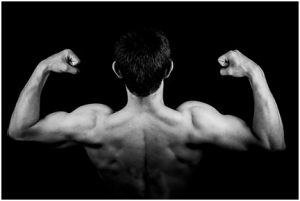Dr. Keith Cronin
Let’s start this topic with the focus on the title and the word “ALL.” I say “all” because the majority of athletes I have seen who suffer from chronic overuse injuries have weak mid-back muscles. And to this day (knock on wood), I have never seen a young athlete in for physical therapy who had chronic low back, neck, or shoulder pain who also had strong mid-back muscles. So going forward, please understand not only the importance of this topic to the safety, health, and overall performance of young athletes but also that this information applies to everyone.
Mid-Back Muscles: What Are We Talking About?
Most athletes are familiar, to some extent, with the anatomy of an athlete. Biceps, pecs, lats, and quads are usually well-known muscle groups that are worked hard in training sessions. Bent-over rows and lat pulldowns are two commonly used and effective exercises for strengthening the large muscles of the back. But we are not talking about the largest muscles of the back today; instead, we are focusing on the smaller ones, such as the erector spinae, a long, strap-like muscle that runs from rib to rib. And even more important to our discussion are the smallest, intrinsic muscles of the back, which run very close to or even right along the spinal column.

These back muscles are analogous to the shoulder’s rotator cuff. The primary function of the intrinsic back muscles is to control and correct body position and movement. Similarly, when you throw a baseball, your lats and pecs drive the throw while your rotator cuff is the steering wheel, keeping the shoulder in check throughout the fast, powerful movement. What happens when your rotator cuff wears out? A little message comes down from your brain that says, “Well, we are done throwing!”
Now, why are these back muscles so important? When you make any movement such as rotating, jumping, cutting, throwing, swinging, or swimming, these muscles are turning on and off to control and correct body position. This group of muscles is so important that yo
ur paraspinal muscles (except for the multifidi muscles) have polysegmental innervation, which means that each muscle has multiple nerve roots to make sure they work correctly. In other words, your mid-back muscles are so vital that your body has determined that all those parts require extra electrical work to ensure nothing goes wrong.
But All Training Is Important—Why Is This Group So Special?
In all honesty, when exercises are p
erformed correctly, these muscles are worked. A good-looking lunge, squat, or standing dumbbell overhead exercise will help strengthen these muscles very well. But here is the reality: You all are working with kids who are adopting this posture most of the day:

Yep, all day long, athletes are placing this important group of muscles in a lengthened, weak position, and then you ask them to put their backs in a neutral to extended position for appropriate exercises. 8 hours of this picture vs. your 30-minute workout—why do you think these kids hate working these muscles? Because it hurts to work out these muscles! It is difficult and painful for kids to get out of their hunched-over position and into the exact opposite position. It’s really, really hard because hunching becomes the habitual comfortable position for athletes and causes their back muscles to become tired and stretched out, which makes it challenging for them to throw weight overhead or do a prone extension exercise.
Back Challenge Accepted!
First, you have to figure out whether there is back weakness with your athletes. Dave Gleason has a great prone extension assessment featured in the Young Athletic Assessment program.
Next, you need to change the mindset of the athlete. How is this possible? It is done by emphasizing strength in these muscles—not pushing strength work to the end of the training session but rather dedicating strength and conditioning sessions to these muscles groups. Athletes can flex their pecs all they want, but if there is not balance with the opposing muscles groups, athletic performance suffers. Telling children to “sit up” at school to keep these muscles strong is a waste of time, but telling a 13-year-old male baseball player that stronger mid-back muscles will help them drive a ball off the inside of the plate? Well, now you have their undivided attention.
Finally, you need to incorporate a series of solid mid-back strengthening exercises. Remember, these are postural muscles, so they respond well to lower weight but higher repetitions. Whether you are performing prone Superman exercises or doing back extensions off an exercise ball, you are probably never going to need more than a 5lb weight in each hand or a strap wrapped around the ankle.
Remember, the mid back muscles are critical to athlete performance and the overall health and wellbeing of young adults and children alike. Weak structural supports carry into early adulthood and can even result in neck and back pains while working. Developing a strong base early on teaches good habits that athletes will carry for decades, improving the quality of their lives as well as their athletic performance.


